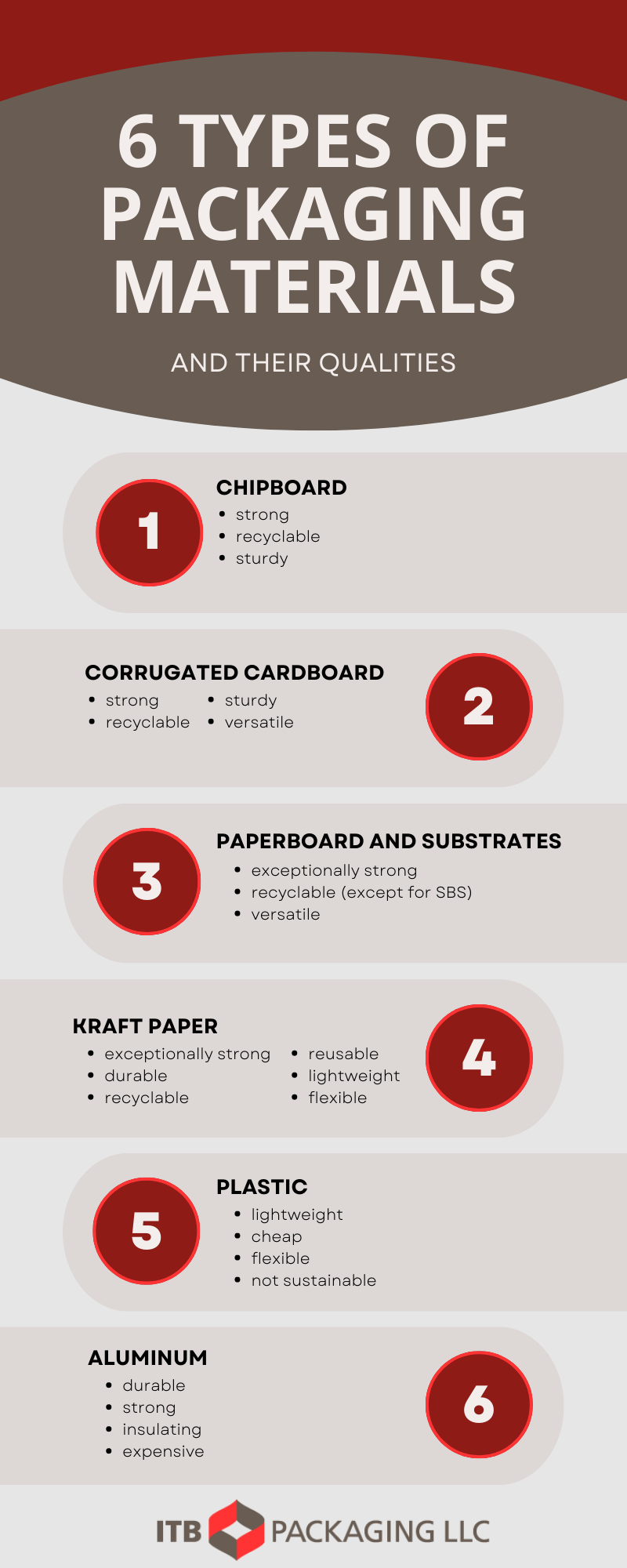OVERVIEW
Manufacturers should choose each level of packaging with the product and supply chain impacts in mind. If you’re researching the various types of packaging materials, you’ve come to the right place. The purpose of this guide is to help you through your packaging selection process by giving you some important considerations and facts about the most commonly used packaging materials.
3 CATEGORIES OF PACKAGING
Before getting into the types of packaging materials available, the first thing to know is there are three broad and sometimes overlapping categories for packaging:
- Primary packaging is the packaging that comes into immediate contact with the product. Think about primary packaging as the container in which the product is stored. For example, the primary packaging of choice for many specialty beverages is glass bottles.
- Secondary packaging not only adds additional protection for the product, but also protects the primary packaging of a product. For example, specialty beverage manufacturer, Cultured Kombucha, protects their primary packaging with our unique secondary divider systems.
- Tertiary packaging is the third category and stage of packaging, usually consisting of shrink wrapped pallets used to transport products in bulk from manufacturers to the retailers.
PACKAGING MATERIAL CONSIDERATIONS
The importance of selecting the most suitable type of packaging material for your products is obvious, but knowing the right questions to ask in making this decision is not always so clear. Consider the following list:
- What is the product form?
Is it solid, liquid, gas, or some combination, etc. Dry powdered or granulated products usually come in a paperboard carton or bag with or without a plastic liner. Solid foods often require a plastic film or bag surrounded by a paperboard container. Any products with a high moisture content will need packaging materials that prevent leaking or saturation.
- What are the characteristics of your product? For example, fragile, perishable and even oddly shaped products each have different requirements for protection and handling through the supply chain.
- How will the product need to be protected? Each product has different properties that require different methods of packaging. Fragile products need to be protected from outside forces and from shifting within the container both of which can cause breakage and damage. Food products also need to be able to withstand the rigors of shipping and delivery, in addition to protection from contamination. Some products have highly sensitive surfaces, such as electronics and require materials that reduce electrostatic discharge.
- How will the package be used?
- Which materials are sustainable or recyclable? As today’s society increasingly values recyclability and sustainability, you should take this into consideration when choosing packaging materials. Not only is it important to your company, but it will also be increasingly important to your customers.
- How much will it cost? One kind of packaging may excel in certain areas when compared to another, but it may come at a much greater expense. The cost of packaging involves a number of considerations when choosing the best packaging materials for your product.
- How will it be transported? It is important to explore all possibilities for transport to find the most efficient option. Some routes may be better than others in terms of fuel efficiency and sustainability.
- How will the product be stored? Some packages will necessitate a controlled atmosphere, whereas others will not. Examining and testing all aspects of the package is essential to confirming that the product will remain unchanged.
- What levels of packaging are needed? Some products require only one or two levels of packaging, but most often, products will require all three. It is important to consider which materials would work best as primary, secondary, or tertiary packaging to best support and protect the product throughout the supply chain.
More questions to consider:
- What are the necessary production quantities?
- What is the production schedule?
- How does your competition package their products?
- Can an existing packaging structure be improved?
TYPES OF PACKAGING MATERIALS
Types of packaging materials include chipboard, corrugated cardboard, paperboard and substrates, plastic, aluminum, and paper. Each one of these materials has its own uses, advantages, and disadvantages:
Chipboard is made from recycled paper and is often used for packaging smaller items like electronics, household goods, clothing, shoes, and other small household items. Chipboard is strong enough to be shipped by itself but is often paired with additional materials like corrugated cardboard to provide further protection during shipping.
Corrugated cardboard is made from three layers—a fluted layer lined with a smooth layer on each side—that are glued together. It is often made from a combination of recycled material and virgin material for strength. Corrugated cardboard is incredibly sturdy and can hold a large amount of weight within its structure. It’s also very versatile in that it can be folded flat for easy storage.
Corrugated cardboard provides more protection than chipboard alone and can be used in tandem with chipboard for added protection or by itself. Partitions are typically used to protect fragile products by dividing them and ensuring they don’t crush into each other.
Paperboard and substrates are made from pulp pressed between two layers of paper. This makes it exceptionally strong and makes it ideal for protecting fragile items such as glass bottles. It also has many other uses, including wrapping food products and for retail display structures. SBS packaging (Solid Bleached Sulfate) is a substrate option that derives from paperboard and is made from bleached and refined chemically pulped fibers. It is typically used in premium packaging for beauty, pharmaceutical, or health products.
Kraft Paper is a paperboard grade using the Kraft process of converting wood into wood pulp that removes linguin and does not include bleaching which can further reduce the paper’s strength. The Kraft paper process can also use all types of wood, unlike other paper processes. It is an environmentally sound choice because nearly all the chemicals used in the process are recovered and reused, it is a self-sustaining method, and the end product is recyclable and often reusable. Kraft paper is exceptionally strong, but also lightweight which keeps shipping costs down, and its course texture, durability, and flexibility provide more protection.
ITB Packaging’s In-The-Box and Pop-N-Drop collapsible divider frames are made of chipboard, and cells come in a variety of materials that provide class A protection including 20# Smooth Kraft and 20# Smooth Kraft with Nomar coating. These material choices are part of what make ITB solutions superior to the typical corrugated dividers.
Plastic is one of the most commonly used primary packaging materials because it is lightweight, cheap, and flexible enough to accommodate almost any shape or size product. Plastic film wraps are also popular for protecting food items from moisture and air exposure during shipping. However, it is important to keep in mind that plastic is no longer a viable option for eco-conscious consumers. Moreover, the second most common source of plastic pollution comes from food packaging.
Aluminum can be used for primary packaging due to its durability and strength. It is also a good insulator that helps keep the product fresh and safe from moisture, sunlight, or other external elements. The downside of aluminum is that it has a high cost, which makes it expensive for the end consumer. This means that aluminum is not suitable for any type of product that will not be sold at a premium price point or where the cost of the product must be kept low. However, aluminum can still be used in situations where the benefits outweigh the cost.
THE BOTTOM LINE
Choosing the most suitable packaging material is not easy, given the number of performance factors that need to be considered. Hopefully, this guide helps you better understand the factors to consider and the available materials along with their advantages and drawbacks.


